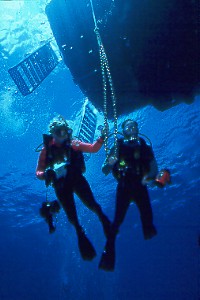|
In the previous article Using your Histogram - Topside and Underwater, I
discussed using your histogram for getting optimal images. Digital SLR’s and some of the newer digital
compact cameras are capable of displaying separate histograms for each color channel - red, green and blue tones.
Your regular histogram is an average of each of these tones. It may not show a spike occuring in one of those
channels.
For underwater images, this can be very helpful. The red channel can guide you on your strobe power. The sun or
your strobe are the only things that provide the red light. Turn up your strobe, or get closer to your subject,
so the red channel just touches the right edge. If there is a spike, just power down or move your strobe back some.
The blue channel is a guide for your water exposure (in tropical waters). Here, slow down your shutter speed until
the blue channel just touches the right edge. We get a terrible cyan blue if we expose too far to the right, and it
can’t be fixed in Photoshop. This is a perfect example of where we can produce a perfect blue background in the
camera and not in the computer.
In macro photography, we are filling the frame with our subjects, and they come in an array of colors, so we
must use all three histograms. In macro, our strobes and aperture are the main players, so these are the adjustments
we need to make to get the most prominenet histogram to expose to the right.
For colder, darker, green waters, your green histogram will be your guide for proper exposure.
So, get out there and experiment, and you will find you will have more keepers with better tones – and you can
spend more time diving and doing photography. Take it from one who hates sitting in front of the computer on a
beautiful day – do whatever you can to minimize your time in Photoshop.
|



